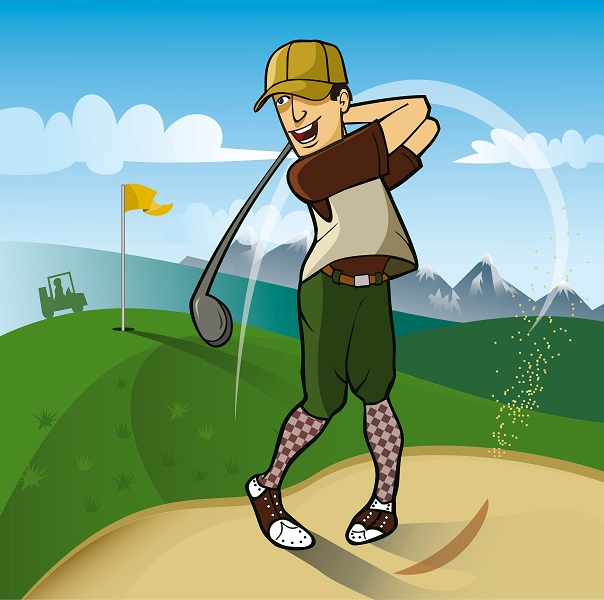How to Hit A Flop Shot
Hitting a flop shot demands a solid, fundamental approach, with a great deal of patience, when striking the golf ball.
Since the flop shot is widely considered the most difficult shot for amateurs, having a step-by-step guide can certainly help shorten the learning curve.

You just need a lob wedge, an open setup position, and a big swing to execute the flop shot. While that might seem easy, the fundamentals of the flop shot can escape even the best amateur golfers out there.
In this article on how to hit a flop shot, I’ll break down the elements of this complicated but necessary golf shot to help you own the greens during your next round.
Why Should I Hit a Flop Shot?
Before we get into the step-by-step guide to hitting a flop shot, let’s answer why you should learn this shot for your short game.
The flop shot pops the ball high into the air so it lands softly on the green and settles close to the cup.
The shot works best when your ball is sitting in high grass (or when you are facing a tough sand shot), and you are worried about the hosel getting caught by tall weeds and snapping closed.
The flop shot greatly improves your chance of taking a swing and getting the golf ball out of trouble with your club in just one stroke.
Too many scorecards are ruined by fighting all day with the rough, so developing a smooth flop shot can alleviate those concerns and inject your short game with confidence.
Open Stance Helps Lift Golf Ball
To hit a flop shot, you need an open stance.
When executing the shot, you want your clubface open and your front foot a few inches behind its normal square position.
The perfect flop shot slides the face under the ball to pop it out of trouble with spin. When used right, the flop shot can save you from carding a double bogey or worse by stopping the ball close to the hole.
The lead foot remains far to the outside from a square position. In fact, if you were drawing a line along the top of your toes, you would aim roughly 45 degrees left of the target for a right-handed golfer.
And as a reminder, the face of your sand wedge remains wide open and is square to the target.
Lie Dictates Ball Position
Let’s start with your stance and how it’s dictated by the ball’s position when hitting flop shots.
When hitting flops, the lie of your ball dictates its position in relation to your feet and where your weight balances at address.
Off a tight lie, you want your weight forward, so you’ll also place the ball forward in your stance. Since there’s no danger of sliding the club under the ball, you will need to impact the ball first, moving that leading edge of the face along the turf to the point of impact.
If your ball is sitting in the rough, you want a balanced stance with the ball in the middle of your stance. In this position, the club will make the play on the golf ball rather than you needing to shift your weight.
Use Highest Lofted Wedge With Bounce
One of the biggest questions I get from students when teaching how to hit a flop shot is what wedge works best to pull off a great shot. For high handicappers and beginners, I suggest using a sand wedge first to gain a sense of what the shot demands.
More experienced golfers can use a 60-degree lob wedge to help them get more height and rotation to their flop shot.
When we add loft, we do lose distance however, so if you are looking to execute the flop shot from a farther distance, realize that unless you have practiced the swing quite a bit, you could land your shot short with a high-lofted club.
Let’s talk about bounce and how it helps your flop shots. Wedge bounce is the measurement between the angle of the club face’s leading edge and the trailing edge’s lowest point. Bounce is significant when executing a flop shot.
Since you are taking a steep swing with the flop shot, having more bounce on the wedge prevents you from hitting straight into the turf and the face from losing all momentum.
The bounce provided by the wedge’s sole helps keep the leading edge underneath the ball even if you are sitting without your ideal lie.
Softer Hands Helps Shot Land Softly
One of the best ways to practice the flop shot is by using softer hands that allow the club face to move easily on the swing and through the impact zone. Since we are quickly hinging our wrists, much like when Phil Mickelson hits a lob shot, you want your hands to have a loose flow.
The soft hands can also help generate more spin as the face moves over the ground and helps pull the face through the shot. Softer hands also allow the upper body to remain tension free.
Once your upper body and feet are set, it is time to hit the shot. Feel free to take a couple of practice swings to simulate the feel when you hit the shot. Your body should play relatively loose throughout these practice swings.
If you must play the shot from a tight lie on the course, then simulate getting your hands forward at impact.
Although you are positioned to aim left, if you swing along your toe line and hit the shot smoothly, your attempt will land softly on the green.
Learning how to hit a flop shot effectively can create an advantage with your short game. Instead of playing chip shots around the green, flop shots offer a softer way to conquer the area of the course around the green.